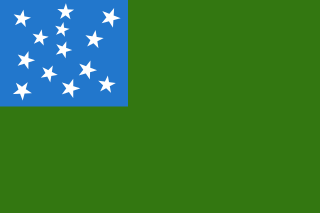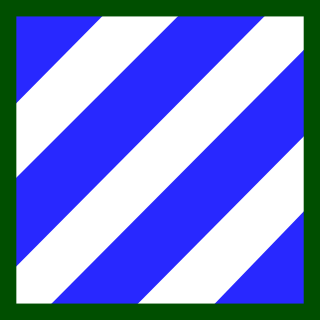
The 43rd Infantry Division was a formation of the United States Army from 1920 to 1963, serving in the Pacific during World War II. It was activated in 1920 as a National Guard Division in Connecticut, Maine, Rhode Island, and Vermont. The 143rd Regional Support Group of the Connecticut National Guard now carries on the heritage.

The 42nd Infantry Division (42ID) ("Rainbow") is a division of the United States Army National Guard. It was nicknamed the Rainbow Division because, during rapid mobilization for service in WW1, it was formed from 27 National Guard units from across the US. The division was engaged in four major operations between July 1918 and the armistice in November 1918, and demobilized in 1919. Since World War I, the 42nd Infantry Division has served in World War II and the Global War on Terrorism (GWOT).

The 41st Infantry Brigade Combat Team ("Sunset") is an element in the Oregon Army National Guard. Headquartered at Camp Withycombe, Clackamas, Oregon, it was part of the 7th Infantry Division based at Ft. Carson in Colorado. The brigade traces its lineage back to the 41st Infantry Division.

The 172nd Infantry Brigade was a light infantry brigade of the United States Army stationed at Fort Wainwright, Alaska and later moved its headquarters to Grafenwöhr, Germany. An active duty independent brigade, it was part of V Corps and was one of five active-duty, separate, brigade combat teams in the U.S. Army before its most recent inactivation on 31 May 2013.
Reconnaissance, surveillance, and target acquisition (RSTA) groups the tasks of reconnaissance, surveillance and target acquisition conducted by the Department of Defense. RSTA supports military operations at a strategic, operational, or tactical level, either by dedicated RSTA forces or those which possess the capability.

The Vermont National Guard is composed of the Vermont Army National Guard and the Vermont Air National Guard. Together, they are collectively known as the Green Mountain Boys. Both units use the original Revolutionary War-era Flag of the Green Mountain Boys as their banner. In 2009, they had 2,600 members.

The New York Army National Guard is a component of the New York National Guard and the Army National Guard. Nationwide, the Army National Guard comprises approximately one half of the United States Army's available combat forces and approximately one third of its support organization. National coordination of various state National Guard units are maintained through the National Guard Bureau.

The Pennsylvania Army National Guard, abbreviated PAARNG, is part of the United States Army National Guard and is based in the U.S. Commonwealth of Pennsylvania. Together with the Pennsylvania Air National Guard, it is directed by the Pennsylvania Department of Military and Veterans Affairs. The PAARNG maintains 124 armories and is present in 87 communities across the Commonwealth.

The 50th Armored Division was a division of the Army National Guard from July 1946 until 1993.

The Georgia Army National Guard is the Army National Guard component of the Georgia National Guard, administratively part of the Georgia Department of Defense. It consists of more than 11,100 citizen-soldiers training in more than 79 hometown armories and regional facilities across the state. Georgia’s Army Guard is the sixth largest in the nation and includes combat, combat support and combat service support units.

The 48th Infantry Brigade Combat Team is a modular infantry brigade of the Georgia Army National Guard. One of the oldest units in U.S. Army history, the lineage of the 48th Infantry Brigade can be traced back to 1825. It is one of few units in the US military that also saw service as a unit of the Confederate States of America during the American Civil War. Today, the 48th IBCT is part of the U.S. Army's "Associated Units" program where it is aligned under the 3rd Infantry Division, a combined arms combat maneuver unit of the Regular Army.

The 86th Field Artillery Regiment is a inactive parent field artillery regiment of the United States Army, last represented in the Vermont Army National Guard by the 1st Battalion, 86th Field Artillery Regiment. Perpetuating the Vermont Light Artillery Batteries of the American Civil War and subsequent Vermont artillery units, the regiment was organized following World War II as the 206th Field Artillery Battalion in the Vermont National Guard. The 206th saw active service in Germany with the 43rd Infantry Division during the Korean War, and became the 124th Artillery, a Combat Arms Regimental System parent regiment, in 1959. Represented by the 1st Howitzer Battalion, 124th Artillery, the regiment was renumbered as the 86th Artillery in 1964 when the 1st Battalion became the brigade artillery battalion of the 86th Armored Brigade. The 1st Battalion served in that role with the brigade for much of the rest of its existence.

The 172nd Infantry Regiment is a Vermont Army National Guard infantry regiment which specializes in mountainous and cold weather operations. It falls under the command of the Vermont Army National Guard's 86th Infantry Brigade Combat Team (Mountain). Before the creation of the Infantry Brigade Combat Team in 2008, the regiment was recognized as the only conventional unit in the United States Army trained and equipped for mountain operations. The regiment draws heritage from the original 10th Mountain Division, which fought during World War II, both in the type of training they conduct and in the specialized equipment the unit maintains.

The 126th Aviation Regiment is a unit of the U.S. Army National Guard.

The 2nd Infantry Brigade Combat Team, 34th Infantry Division is an Iowa Army National Guard unit headquartered in Boone, Iowa.

The 102nd Infantry Regiment currently consists of one battalion in the Connecticut National Guard. In the modern U.S. Army regimental system, regimental designation is used only in historical tradition, and there is no regimental headquarters or staff. It is one of several National Guard units with colonial roots. The 1st Battalion, 102nd Regiment is headquartered in New Haven, Connecticut. Its mascot is Sergeant Stubby.

The 44th Infantry Brigade Combat Team is an infantry brigade combat team of the New Jersey National Guard. It is headquartered at the Lawrenceville Armory in Lawrenceville, New Jersey, United States. The 44th Brigade Combat Team is the major unit of the New Jersey Army National Guard. The 44th Brigade Combat Team has three light infantry battalions, one field artillery battalion, one cavalry squadron, an engineer battalion, and a support battalion.

Gregory C. Knight is a United States Army officer. In 2019, he was selected to serve as Adjutant General of Vermont.

The 172nd Cavalry Regiment is an armored cavalry regiment of the Vermont Army National Guard, with one battalion currently active. First organized in 1861, the regiment has seen combat in the American Civil War, World War I, World War II, and the War on Terror. Originally an infantry regiment, elements of the unit were consolidated with an antiaircraft unit in 1959 and converted into an armored regiment. In 1964, the remainder of the 172nd Infantry was consolidated with the 172nd Armor, as an armored regiment. In 2007, elements became an armored cavalry regiment. In 1982, a new infantry unit designated the 172nd Infantry Regiment was organized in the Vermont Army National Guard, but it is not lineally related to the previous 172nd Infantry/Cavalry, sharing the numerical designation only for historical purposes.






















